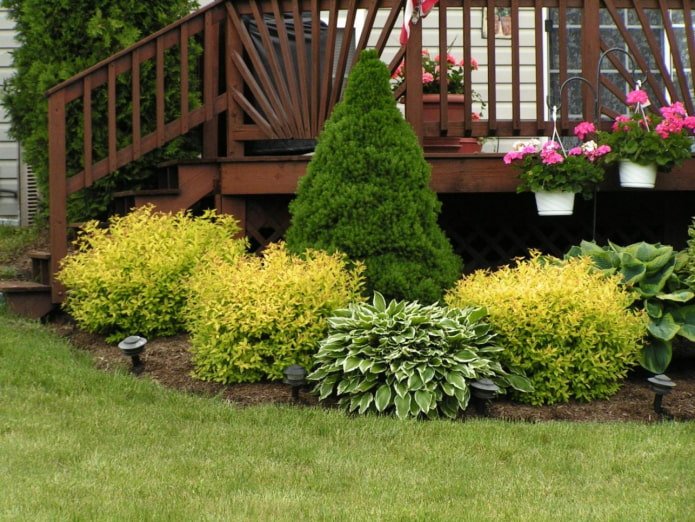Roses
Brightly blooming roses in combination with conifers create an organic ensemble. For such flower beds, you should choose medium- or low-growing shrubs. Mountain pine, thuja, and Canadian spruce are perfect. When creating a flower bed, follow several rules that will help the bushes grow in complete harmony with each other:
- young bushes are planted 1-1.5 meters from the conifer so that the root system can strengthen;
- low-growing roses are placed at the edge of the flower bed, and bush and standard varieties are closer to the thuja or juniper;
- open ground between conifers and rose bushes is sprinkled with pebbles or gravel. The rocky layer will rid the flowerbed of weeds and will not allow the soil to dry out in hot weather.


Lilies
Another companion of evergreen shrubs is considered to be the garden lily. Slender perennials with a spreading inflorescence, depending on the variety, can reach from 50 to 150 cm in height. They form a harmonious tandem with both horizontal juniper and taller thuja.
Tubular lilies are suitable for decorating garden paths. In combination with dwarf conifers, they form picturesque garden labyrinths for walks on summer evenings.
Curly lily requires shading of the root system for abundant flowering. Cypress, various varieties of juniper or small spruce trees can easily cope with this task.


Smolevka
You can create a semblance of a mountain landscape on your site by experimenting with combining several coniferous shrubs in one flowerbed. A scattering of stones and cushion-shaped and creeping flowers, such as the campion, give the landscape a finished look.
A bright blanket of small flowers adds color to the rock garden, looks natural and unobtrusive. The plant does not require special care, and takes root well in sandy soils.

Saxifrage
Another favorite companion for evergreens among landscape designers is the garden saxifrage. Rocky, loose, well-drained soil is suitable for planting perennials.
Saxifrage grows next to dwarf conifers: firs, spruces, pines. In flowerbeds with diffused light, it quickly grows, forming a green carpet with star-shaped buds.

Cereals
Cereals are often found in nature next to evergreen crops. You can also use this combination in your garden. Fescue, pogonatherum, setaria, feather grass, miscanthus add lightness and playfulness to flowerbeds. Cereals fit equally laconically into rockeries, alpine slides and flowerbeds framing ponds.
Despite their splendor, decorative ears and panicles do not block sunlight, so they often accompany young seedlings of dwarf mountain pines and spruces. With the onset of frost, cereals do not lose their splendor and continue to please the eye.

Heather
Heather is valued by gardeners for its decorative qualities. In nature, this highly branched, evergreen shrub is found in coniferous-broadleaf forests and grows on mountain slopes, so it is no stranger to conifers.


Ferns
Owners of tall pines, firs and cedars should pay attention to garden ferns. They are used to decorate flower beds, streams or are planted around trees.
The ideal conditions for fern growth are a shaded area with non-drying soil. Unlike other perennials, they cope well with increased soil acidity – the result of the vital activity of coniferous crops. Ferns do not require special care, grow widely and have a rich color in natural conditions.

Barberry, spirea and other shrubs
Not only flower beds, but also deciduous shrubs can make good neighbors to junipers, thujas and pines. At the beginning of summer, the rich color of conifers will become a noble background for lush inflorescences of lilac, hydrangea, spirea, barberry. By the beginning of autumn, the reddened and yellowed foliage will play with the greenery in new colors, and the flowerbed will not lose its attractiveness.

To make cedars, pines and spruces fit into the landscape of the site, draw inspiration from nature. The most natural composition, close to a forest or mountain landscape, will always be interesting and harmonious.
Now reading:
- Country Style Bedroom: 40 Inspiring Photos and Design Tips
- ideas on how to effectively use the corner in your kitchen unit.
- Tips for choosing a sink made of artificial stone: advantages, disadvantages and options.
- 14 design projects for stylish modern interiors of small apartments.
- Coffee tables: more than 100 creative ideas for your interior.